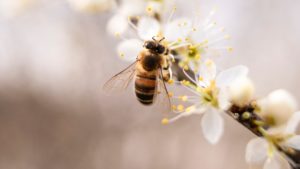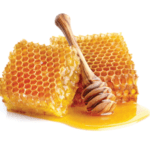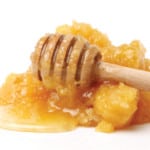The difference between raw honey and pure honey is lost on many. Runny honey? Rock hard? “Who cares! Just pop it in the microwave!” Well, hypothetical person, honey is actually more complex than that. Honey is made of delicate sugars, water, vitamins, antioxidants, enzymes, and minerals that can be damaged when overheated. Let’s take a proverbial “Magic School Bus” dive into the honey pail. It’s time to educate yourself on the chemistry of this ancient ambrosia, how to keep it from pasteurization, and why.
The Sting: A Bee’s Process for Makin’ Honey
![]()
 So why do bees make honey in the first place? Turns out we’re not the only ones who like honey on our toast. Bees eat honey and save it to live on during the winter. Forager bees collect nectar from flowering plants and take it back to the hive in their honey stomach (also known as honey crop), and transfer it over to house bees. Then, over a 20-minute period they will process the nectar in their crop, absorbing the water and breaking down the larger sucrose sugar molecules into smaller glucose and fructose sugars.
So why do bees make honey in the first place? Turns out we’re not the only ones who like honey on our toast. Bees eat honey and save it to live on during the winter. Forager bees collect nectar from flowering plants and take it back to the hive in their honey stomach (also known as honey crop), and transfer it over to house bees. Then, over a 20-minute period they will process the nectar in their crop, absorbing the water and breaking down the larger sucrose sugar molecules into smaller glucose and fructose sugars.
No, honey isn’t “bee vomit,” or “bee-barf” as my coworker likes to call it. This is because regurgitation is voluntary, and never passes through the bees central digestive system. After regurgitation, the bees will then deposit the nectar-turned-honey into honeycomb, and will fan it with their wings. This helps to further dehydrate the honey, which gives it preservative qualities. The low water content in honey, below 20%, also makes it uninhabitable for bacteria. This low water content and acidic properties gives honey antiseptic qualities too, good for topical use and health treatments, like for a common sore throat.
What is Honey Made Of? A Sticky Situation
Honey is made of different sugars, water, vitamins, antioxidants, enzymes, and minerals. Raw honey comes straight from the hive, after an apiarist lightly filters it by hand to remove any debris. This preserves the nutritional qualities of the honey. Processed honey is heated at 70 degrees Celsius and then rapidly cooled, killing and destroying beneficial bacteria, enzymes, pollen, antioxidants, vitamins, and minerals. This, and intense straining “purify” the honey and is done mostly for aesthetic reasons. All in all, processed honey is significantly less beneficial for your body just so it will look pretty on the shelf.
Types of Bees
The three types of honey bees include the queen bee, the worker bee and the drone. They each play an important part in the hive that allows for successful honey production.
- Queen Bee
The queen bee is slightly larger than the others, and her role is one of production. She can lay up to 2,000 eggs and can live for close to five years. Beekeepers should know how to recognize the queen bee because she is essential to the colony. Those in the honey industry know that a colony is in trouble when the queen bee is absent.
- Worker Bee
Worker bees are female and don’t reproduce like the queen bee. As expected from their name, they handle most of the tasks in the colony. Their to-do list includes making honeycombs, taking care of the queen and young larvae, foraging for nectar and pollen and protecting the hive. They take on each role at a different time in their short life of about five weeks to several months.
- Drone Bee
The male honeybees are called the drones and are developed from unfertilized eggs. They are larger than the worker bees and their purpose is to fertilize queen bees and sometimes patrol mating sites. Drone bees typically live about three months and are kicked out of the hive when cold weather approaches.
How They Make Honey
Forager bees collect nectar from flowering plants and take it back to the hive in their honey stomach, also known as honey crop, and transfer it over to house bees. Then, over a 20-minute period they will process the nectar in their crop, absorbing the water and breaking down the larger sucrose sugar molecules into smaller glucose and fructose sugars.
No, honey isn’t “bee vomit;” this is because regurgitation is voluntary and never passes through the bee’s central digestive system. After regurgitation, the bees will then deposit the nectar-turned-honey into honeycomb and will fan it with their wings. This helps to further dehydrate the honey, which gives it preservative qualities. The low water content in honey, below 20%, also makes it uninhabitable for bacteria. This low water content and acidic properties gives honey antiseptic qualities too, good for topical use and health treatments, like for a common sore throat.
WHAT IS HONEY MADE OF?
A sweet substance, honey is made of different sugars, water, vitamins, antioxidants, enzymes and minerals. Because most of the moisture is removed during the honey-making process from bees, it never really goes bad.
Processed Honey
Processed honey is heated at 158 degrees Fahrenheit (70 degrees Celsius) and then rapidly cooled, killing and destroying beneficial bacteria, enzymes, pollen, antioxidants, vitamins and minerals. This, including intense straining to “purify” the honey, is done mostly for aesthetic reasons. All in all, processed honey is significantly less beneficial for your body just so it will look pretty on the shelf.
Raw Honey
Raw honey comes straight from the hive, after an apiarist lightly filters it by hand to remove any debris. This preserves the nutritional qualities of the honey. Raw honey doesn’t need to be pasteurized and is packed with natural antioxidants that offers a plethora of benefits. While it never spoils, raw honey tends to crystalize more rapidly.
CARING FOR HONEY
An important part of a beekeeper’s job is maintaining the proper viscosity of the honey. When beekeepers remove honey from the hive, they usually keep it in pails. Hive temperatures average between 89 and 95 degrees Fahrenheit. If the weather is cold enough, depending on the type of honey, it will begin to crystallize. A bee blanket is a great solution to keep your honey the same temperature as the hive. This ensures preservation of its nutritional value. Honey heaters offer even heat distribution, which helps preserve the health benefits of honey without overheating or burning it.
Because honey is a pure and natural substance, it is regarded as a highly effective solution for many ailments. You’ll think of honey as much more than just a delightful sweetener after understanding the hard work it takes to make. Check out the following infographic for more information on what honey is made of.
Crystal Clear: Decrystallize Raw Honey
When apiarists and beekeepers remove honey from the hive, they usually keep it in pails. Hive temperatures average between 89º to 95º Fahrenheit. If the weather is cold enough, depending on the type of honey, it will begin to crystallize. A honey bucket heater or honey drum heater is a great solution to decrystallize raw honey without heating it enough to pasteurize it and helping preserve its nutritional value.
Check out this infographic for more information on what honey is made of!

Sources
Charlotte, Beekeeper, Pete Jones, and Beekeeper Charlotte. “What Do Honeybees Do With Pollen?” Carolina Honeybees. October 15, 2018. Accessed November 13, 2018. https://carolinahoneybees.com/why-pollen-is-vital-for-honeybee-survival/.
Common Disease Problems. Accessed November 13, 2018. https://www.uaex.edu/farm-ranch/special-programs/beekeeping/about-honey-bees.aspx.
“Honey, Recipes, Research, Information.” National Honey Board. Accessed November 13, 2018. https://www.honey.com/faq.
https://www.livescience.com/4255-oldest-bee-fossil-creates-buzz.html
http://www.chm.bris.ac.uk/webprojects2001/loveridge/index-page3.html
https://www.compoundchem.com/2014/08/21/chemistryofhoney/
Frequently Asked Questions
What is honey actually made of?
Honey is primarily composed of sugars like fructose and glucose, along with water, vitamins, antioxidants, enzymes, and minerals, all of which contribute to its nutritional and preservative qualities.
Where does honey come out from a bee?
Honey is not directly excreted by bees; instead, bees regurgitate nectar from their honey stomachs into honeycombs, where it is dehydrated and transformed into honey.
How do bees create honey?
Bees create honey by collecting nectar, which is then processed and dehydrated in the hive using their wings to fan it, turning it into the thick, sweet substance we know as honey.
What is the main ingredient of honey?
The main ingredient of honey is fructose, which is present in the highest quantity among its various components.
The Powerblanket Bee Blanket will maintain the same temperature as a hive, ensuring your honey is always at the perfect temperature.









